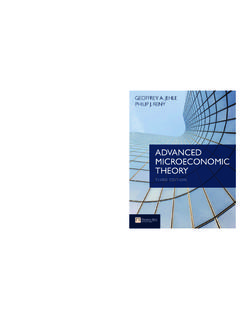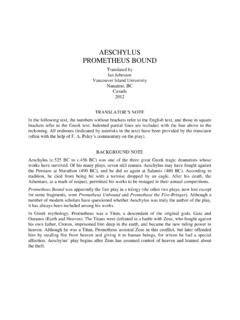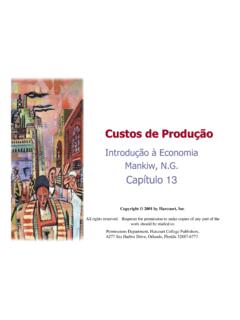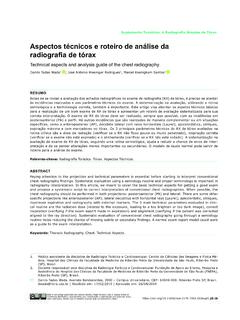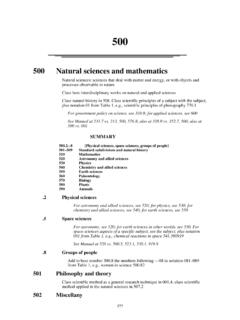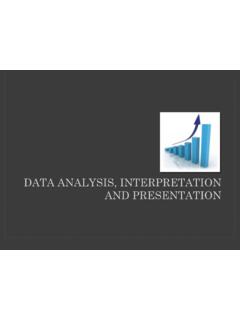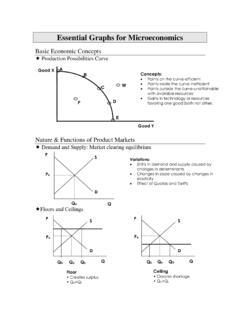Transcription of Microeconomic Theory: Basic Principles and Extensions
1 MICROECONOMICTHEORYBASIC Principles AND EXTENSIONSTENTH EDITIONThis page intentionally left blank MICROECONOMICTHEORYBASIC Principles AND EXTENSIONSTENTH EDITIONW alter NicholsonAmherst CollegeChristopher SnyderDartmouth CollegeVP/Editorial Director:Jack W. CalhounEditor-in-Chief:Alex von RosenbergExecutive Editor:Mike RocheSr. Developmental Editor:Susan SmartSr. Content Project Manager:Cliff KallemeynProduction TechnologyAnalyst:Adam GrafaExecutive MarketingManager:Brian JoynerSr. Marketing Manager:John CareyArt Director:Michelle KunklerSr.
2 First Print Buyer:Sandee MilewskiPrinter:West GroupEagan, MNMicroeconomic TheoryBasic Principles and ExtensionsTenth EditionWalter Nicholson Christopher SnyderCOPYRIGHT 2008, 2005 Thomson South-Western, a partof The Thomson , the Star logo, andSouth-Western are trademarksused herein under in the United States ofAmerica1234510090807 ISBN 13: 978-0-324-42162-0 ISBN 10: 0-324-42162-1 ALL RIGHTS part of this work covered bythe copyright hereon may bereproduced or used in any formor by any means graphic, elec-tronic, or mechanical, includingphotocopying, recording, taping,Web distribution or informationstorage and retrieval systems, orin any other manner withoutthe written permission of permission to use materialfrom this text or product, submit arequest online at of Congress ControlNumber.
3 2007921464 Thomson Higher Education5191 Natorp BoulevardMason, OH 45040 USAFor more information aboutour products, contact us at:Thomson Learning AcademicResource Center1-800-423-0563To Beth, Sarah, David, Sophia, and AbbyTo MauraThis page intentionally left blank About the AuthorsWalter Nicholson is the Ward H. Patton Professor of Economics at Amherst College. Hereceived his in mathematics from Williams College and his in economics fromMIT. Professor Nicholson s principal research interests are in the econometric analyses oflabor market problems including unemployment, job training, and the impact of inter-national trade.
4 He is also the co-author (with Chris Snyder) ofIntermediate Microeconomicsand Its Application, Tenth Edition(Thomson/South-Western, 2007).Professor Nicholson and his wife, Susan, live in Amherst, Massachusetts, and Naples,Florida. What was previously a very busy household, with four children everywhere, is nowrather empty. But an ever-increasing number of grandchildren breathe some life into theseplaces whenever they visit, which seems far too M. Snyder is a Professor of Economics at Dartmouth College. He received in economics and mathematics from Fordham University and his in economicsfrom MIT.
5 Before coming to Dartmouth in 2005, he taught at George WashingtonUniversity for over a decade, and he has been a visiting professor at the University ofChicago and MIT. He is currently President of the Industrial Organization Society andAssociate Editor of theInternational Journal of Industrial Organization and Review ofIndustrial Organization. His research covers various theoretical and empirical topics inindustrial organization, contract theory , and law and Snyder and his wife Maura Doyle (who also teaches economics at Dartmouth)live within walking distance of campus in Hanover, New Hampshire, with their threeelementary-school-aged page intentionally left blank Brief ContentsPart 1 IntroductionChapter 1: Economic Models3 Chapter 2: Mathematics for Microeconomics19 Part 2 Choice and DemandChapter 3: Preferences and Utility87 Chapter 4.
6 Utility Maximization and Choice113 Chapter 5: Income and Subtitution Effects141 Chapter 6: Demand Relationships among Goods182 Chapter 7: Uncertainty and Information202 Chapter 8: Strategy and Game Theory236 Part 3 Production and SupplyChapter 9: Production Functions295 Chapter 10: Cost Functions323 Chapter 11: Profit Maximization358 Part 4 Competitive MarketsChapter 12: The Partial Equilibrium Competitive Model391 Chapter 13: General Equilibrium and Welfare441 Part 5 Market PowerChapter 14: Monopoly491 Chapter 15: Imperfect Competition521 Part 6 Pricing in Input MarketsChapter 16: Labor Markets573 Chapter 17: Capital and Time595 Part 7 Market FailureChapter 18: Asymmetric Information627 Chapter 19.
7 Externalities and Public Goods670ixBrief Answers to Queries701 Solutions to Odd-Numbered Problems711 Glossary of Frequently Used Terms721 Index727xBrief ContentsContentsPreface xixPART 1 INTRODUCTION 1 CHAPTER 1 Economic Models 3 Theoretical Models 3 Verification of Economic Models 3 General Features of Economic Models 5 Development of the Economic theory of Value 8 Modern Developments 16 Summary 17 Suggestions for Further Reading 18 CHAPTER 2 Mathematics for Microeconomics 19 Maximization of a Function of One Variable 19 Functions of Several Variables 23 Maximization of Functions of Several Variables 28 Implicit Functions 31 The Envelope Theorem 32 Constrained Maximization 36 Envelope Theorem in Constrained Maximization Problems 42 Inequality Constraints 43 Second-Order Conditions 45 Homogeneous Functions 53 Integration 56 Dynamic Optimization 60 Mathematical Statistics 64 Summary 74 Problems 75 Suggestions for Further Readings 79 Extensions .
8 Second-Order Conditions and Matrix Algebra 81xiPART 2 CHOICE AND DEMAND 85 CHAPTER 3 Preferences and Utility 87 Axioms of Rational Choice 87 Utility 88 Trades and Substitution 91A Mathematical Derivation 97 Utility Functions for Specific Preferences 100 The Many-Good Case 104 Summary 105 Problems 106 Suggestions for Further Reading 109 Extensions : Special Preferences 110 CHAPTER 4 Utility Maximization and Choice 113An Initial Survey 114 The Two-Good Case: A Graphical Analysis 114 Then-Good Case 118 Indirect Utility Function 124 The Lump Sum Principle 125 Expenditure Minimization 127 Properties of Expenditure Functions 130 Summary 132 Problems 132 Suggestions for Further Reading 136 Extensions .
9 Budget Shares 137 CHAPTER 5 Income and Substitution Effects 141 Demand Functions 141 Changes in Income 143 Changes in a Good s Price 144 The Individual s Demand Curve 148 Compensated Demand Curves 151A Mathematical Development of Response to Price Changes 155 Demand Elasticities 158 Consumer Surplus 165 Revealed Preference and the Substitution Effect 169 Summary 172 Problems 173xiiContentsSuggestions for Further Reading 176 Extensions : Demand Concepts and the Evaluation of Price Indices 178 CHAPTER 6 Demand Relationships Among Goods 182 The Two-Good Case 182 Substitutes and Complements 184 Net Substitutes and Complements 186 Substitutability with Many Goods 188 Composite Commodities 188 Home Production, Attributes of Goods, and Implicit Prices 191 Summary 195 Problems 195 Suggestions for Further Reading 199 Extensions .
10 Simplifying Demand and Two-Stage Budgeting 200 CHAPTER 7 Uncertainty and Information 202 Mathematical Statistics 202 Fair games and the Expected Utility Hypothesis 203 The von Neumann Morgenstern Theorem 205 Risk Aversion 207 Measuring Risk Aversion 209 The Portfolio Problem 214 The State-Preference Approach to Choice under Uncertainty 216 The Economics of Information 221 Properties of Information 221 The Value of Information 222 Flexibility and Option Value 224 Asymmetry of Information 225 Summary 226 Problems 226 Suggestions for Further Reading 231 Extensions : Portfolios of Many Risk Assets 232 CHAPTER 8 Strategy and game theory 236 Basic Concepts 236 Prisoners Dilemma 237 Nash Equilibrium 240 ContentsxiiiMixed Strategies 247 Existence 251 Continuum of Actions 252 Sequential games 255 Repeated games 259 Incomplete Information 268 Simultaneous Bayesian games 268 Signaling games 273 Experimental games 281 Evolutionary games and Learning 282 Summary 283 Problems 284 Suggestions for Further Reading 287 Extensions .
